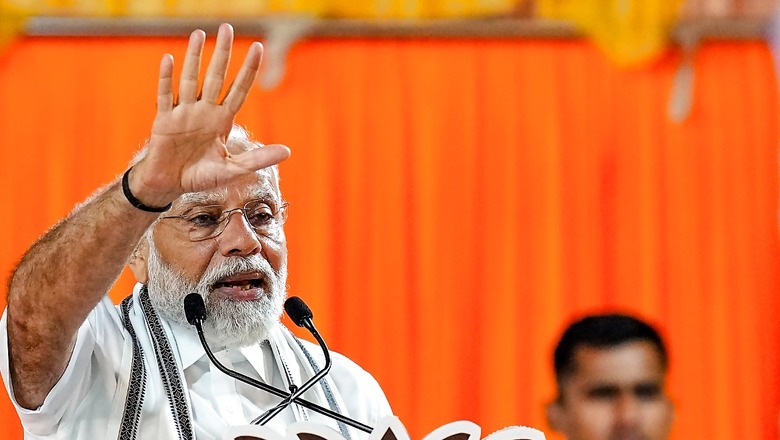
views
It has become more evident with time that Rahul Gandhi has to go a long way to understand the nation, and while put to comparison with a massively popular leader like PM Modi, Gandhi will be no better than a disrespectful novice. At the completion of the Bharat Jodo Nyaya Yatra in Mumbai, Rahul Gandhi made the statement, “There is a word ‘Shakti’ in Hinduism. We are fighting against a shakti too.” For crores of Hindus who have grown up celebrating the enduring tradition of Ṡhakti and who do not second Ṡhakti worship to any other force, it is by far the cruellest remark by Rahul Gandhi.
With enormous visible political disappointment (losing Congress bastion of Amethi) and consequent frustration, Gandhi initially turned to subvert his political disconnect and non-commitment to blaming the vibrant democratic practices followed by PM Modi, and now attacking the most revered symbol of the Hindu faith, the ‘Ṡhakti’. David R. Kinsley, in his Hindu Goddesses: Visions of the Divine Feminine in the Hindu Religious Tradition, Berkeley: University of California Press, 1986 has defined Ṡhakti as power. He further contends, “In Hindu philosophy and theology sakti is understood to be the active dimension of the godhead, the divine power that underlies the godhead’s ability to create the world and to display itself. Within the totality of the godhead, sakti is the complementary pole of the divine tendency toward quiescence and stillness. It is quite common, furthermore, to identify sakti with a female being, a goddess, and to identify the other pole with her male consort. The two poles are usually understood to be interdependent and to have relatively equal status in terms of the divine economy.”
AL Basham wrote in his magnum opus, The Wonder that Was India, “The theme of shakti perhaps grew out of a conflict and eventual compromise between a powerful matriarchal culture that existed in India before the Aryan migrations 2500 B.C.E. and the male-dominated society of the Aryans. The Mother Goddess of the Indus Valley people never really gave place to a dominant male. The Earth Mother continues to be worshipped in India as the power that nurtures the seed and brings it to fruition. This basic reverence of an agricultural people affirms that man is really dependent on woman for she gives life, food and strength. Mother Goddesses were worshipped at all times in India.”
The term Ṡhakti refers to multiple layered ideas centring on a dynamic energy that is responsible for the creation, maintenance, and destruction of the universe. It is identified as symbolising feminine energy because Ṡhakti is responsible for creation, as mothers are responsible for birth. Without Ṡhakti, the universe would stagnate; she stimulates Ṡhiva, which is passive energy in the form of consciousness, represented by the concept of the Ardhanāriśvar.
Ardhanāriśvara combines both male and female attributes equally, illustrating that the creation, maintenance, and destruction of the universe is dependent equally on both forces. Ṡhakti also refers to the manifestations of this energy, namely goddesses. Ṡhakti may be personified as the gentle and benevolent Uma, consort of Ṡhiva, or Kāli, the power of destroying evil forces, or Durga, the warrior who conquers forces that threaten the stability of the universe. Goddess worshippers often view their deity as the all-powerful Supreme Being, second not even to a male god. The Hindu tradition also considers women the vessels of Shakti.
In stark contrast to such misguided disposition of Rahul Gandhi, the incumbent Narendra Modi government in its endeavour to shower reverence and significance to Ṡhakti, has initiated and implemented a host of gender-centric welfare schemes for the upliftment of the conditions of women. And his stress on Nari Shakti represents his commitment to gender justice and gender equality.
One can be conclusive about the fact that it’s only the BJP that understands the religious sentiments of the crores of Hindus and PM Modi can feel the pulse of this sentiment.
Modi’s Twin Plank: Vikas and Dharma
The verse 5.3.14, ‘asiddhārthā nivartante nahi dhīrāḥ kṛtodyamāḥ’ (the strong-minded ones, once having put in efforts do not turn back till they have achieved their objective) of the Kathāsaritasāgara (an 11th Century Sanskrit text collection of the early Indian legends composed by Somadeva), best describes the modus operandi of PM Modi, who looks set to return to power for a rare third term. In the last two terms, the government, under the astute leadership of PM Modi, has excelled in all parameters of good governance and holistic development.
The Lok Sabha elections will be held in seven phases, kicking off on April 19 and the results will be declared on June 4, 2024. The highly intense, mathematically driven, first-past-the-post elections of the Indian Republic require unfaltering political strategising, where the BJP excels more than other political formations, especially the INC. The Opposition, a motley of disarranged political parties including the Congress, can hardly be anticipated to dent the soaring popularity of the Modi magic.
The BJP’s latest landslide election victories in the Hindi heartland testifies in a confirmatory tone that Modi with his overwhelming achievements in the last two terms, spanning over a decade, has swept the world’s largest democracy, overshadowing a disarrayed incoherent Opposition. The Congress was routed by the BJP in the last two Lok Sabha elections in 2014 and 2019. The Congress’ annihilation from the electoral race is due to its lack of a coherent national agenda, effective and dedicated party leadership, internal decay manifesting in the form of intra-party feuds, inertia, and ineptitude.
Jefferies, the leading global, full-service investment banking and capital markets firm, while forecasting a definite return of Narendra Modi to power, has stated that the Opposition’s INDIA bloc of 26 parties may markedly fail to make any significant dent in the NDA’s tally.
Modivian concept of good governance
PM Narendra Modi has set good governance as the key to his administrative excellence, which is citizen-centric with a motto of ‘last mile delivery’. The Modivian concept of good governance is based on a better model of governance than the much-followed ‘Weberian legal-rational model’, as the former adds the moral dimension to the other two pillars. And with remarkable achievements in good governance, anti-incumbency has become visibly irrelevant. The pursuit of inclusive development is rooted in the primary objective of establishing a sturdy foundation for macroeconomic stability, aiming to benefit broader segments of society – an inherently legitimate goal.
Despite global strides in poverty reduction, a pervasive sense of increasing inequality has fuelled discontent with development outcomes. Inclusive growth, the cornerstone of this endeavour, is characterised by economic growth that is equitably distributed across society, offering opportunities for all. Achieving inclusive development entails not only enhancing average achievements but also diminishing disparities in these achievements. It is a multifaceted approach involving the creation of employment opportunities, poverty reduction, and ensuring that essential services in health and education are accessible to all, especially the marginalised. This comprehensive vision extends to promoting equality of opportunity, empowering vulnerable sections through education and skill development, fostering ecological sustainability, advocating for good governance and contributing to the establishment of a gender-sensitive society through women empowerment initiatives.
This entire discussion on governance revolves around the most important aspect i.e. the state and changing notion of governance. State at no point in time has become a redundant entity and was always at the centre of discussion on governance. One also has to understand that the ultimate goal of governance has been human welfare since the Vedic times. The Yajurveda, a later Vedic text, includes Ṡukla Yajurveda of which about 16 recensions are known, of which only 2 recensions have survived (i.e. the Madhyandina and Kanva) includes a prayer wherein a ruler prays, “let my subjects be satisfied, my herds be satisfied, my people be satisfied, let not my people be needy.” The following verses also exhibit the same spirit of governance –
Sarvē bhavantu sukhinah, sarvē santu nirāmayāh |
sarvē bhadrāṇi paśyantu, mā kasċid duhkha-bhāga-bhavēt
(Uvaṭa’s Mantrabhāṣya of Vājasaneya Saṁhitā)
(Translation: may all become happy, may all be free of sickness, may all can see the auspiciousness of all that is good, may none be distressed) is the defining philosophy of ancient Indian political thought. A close examination of the ancient Indian treatises on statecraft and dharma would inarguably reveal the core concept of ‘Yogakshema’ or the welfare of the people as the ultimate goal of any ruler or government. The idea of welfare though, discussed in various ancient Indian texts, was much broader than the idea that informs the contemporary discourse on governance but the Modivian model resonates with the broader concepts of statecraft propounded by the ancient Indian texts. The Yogakshema model perceives governance in a more integral manner catering to not only physical but also meta-physical aspects of human life and society. It not only enables society to raise its overall quality of life at the mundane level but also assists in raising the level of consciousness at a universal level.
Ancient Indian treatises like the Ṡāntiparva, Nītisāra or the Kautilya Arthaśāstra fundamentally highlight governance as an important medium to achieve overall welfare or Yogakhsema of the people. While most of these texts interpreted Yogakshema as the welfare of the people, in the Kautilya Arthaśāstra it is used in the context of a social security system. The duty of Yogakshema is harmonised with the pillar of fairness. It refers to the manner in which the business is conducted without any deterrent in the interest of the stakeholders. And this forms the main plank of the Modivian model of good governance.
The other dimensions of good governance, according to the Kautilya Arthaśāstra also emphasised by the Modi government, are (1) provision of national security and public infrastructure through the construction of roads to facilitate the integration of the territory and promote commerce, (2) formulation of efficient (farsighted and well thought-out) policies and their effective implementation, removal of all obstructions to economic growth and tax incentives to encourage capital formation, and (3) ensuring a fair, welfarist model of and clean administration. Kautilya emphasises the need for economic growth and development, which in his view is a key to political stability and power. Kautilya provided three justifications for economic growth: (1) It was a king’s moral duty, (2) It was essential for political stability, and (3) It enhanced national security thus evolving a critical security-development matrix. Kautilya further suggested tax incentives to promote economic growth through encouraging capital formation. Inarguably, capital formation is at the core of the Modivian development model which creates a paradigm of governance that considers economic growth to be realised by ensuring the creation of robust public infrastructure.
The governmental initiatives under Narendra Modi’s leadership contribute to establishing a holistic, sustainable paradigm of development that transcends sectors and societal segments and is highly gender inclusive. While the vision aligns with international standards, it distinctly reflects India’s cultural essence, aiming to foster a profound sense of national pride among its citizens. Modi’s strategic approach involves transforming challenges into opportunities, steering India toward an intense and inclusive trajectory of development. This forward-looking, long-term perspective underscores the commitment to shaping a future that not only meets global benchmarks but also preserves and celebrates India’s rich cultural heritage.
India is among the fastest-growing major economies in the world. The IMF projects India to hit $6 trillion in 2028. India registered 7.8 per cent growth in the first quarter of FY24, bolstered by the government’s capital expenditure expansion and domestic demand. By the next decade, India is expected to grow to be one of the three top economies following the double engine approach which fosters all-round development, inclusivity and good governance. Today, India is the fastest growing economy possessing robust democratic credentials and a mixed middle-income developing social market economy strategy. And this will allow India to reduce inequality, increase social expenditure and provide employment to all.
Poverty alleviation
The Modi government has launched numerous schemes for poverty alleviation. Pradhan Mantri Garib Kalyan Anna Yojna (PMGKAY) is a food security welfare scheme inaugurated on March 26, 2020. It strives to feed the poorest citizens of the nation through the Public Distribution System (PDS) to all the ration card holders and those identified by the Antyodaya Anna Yojana scheme. A total of 80 crore people have profited from this scheme and delivered free food grains with 5 kg of rice or wheat (as per regional dietary preferences) per person and 1 kg of dal to each family holding a ration card provided under PMGKAY. Garib Kalyan Rozgaar Abhiyaan, (GKRA) began on June 20, 2020, for the returnee migrant workers and rural citizens to empower them and provide employment. This scheme was able to employ migrant workers by focusing on the implementation of 25 different types of work and created an infrastructure in the rural areas of India with a resource envelope of Rs 50,000 crore. Atal Pension Yojana, (APY) which provides a monthly pension for people from the unorganised sector between 18 to 50 years, was launched on May 9, 2015. PM Ujjwala Yojana, (PMUY) inaugurated on May 1, 2016, has delivered more than nine crore free LPG connections to BPL families at subsidised rates. Pradhan Mantri Street Vendor’s Atmanirbhar Nidhi scheme (PMSVA Nidhi Scheme), inaugurated on June 1, 2020, helped street vendors resume their livelihood activities who were impacted by Covid. It facilitated loans to working capital up to Rs 10,000 at a subsidised rate of interest.
From Swachh Bharat Mission, Jan Dhan Yojana, and Ujjwala Yojana to Ayushman Bharat Pradhan Mantri Jan Arogya Yojana, and Startup India, to name a few, his historic decisions and policymaking ideas have weaved India into a newer outlook in front of the world – a strong developing nation. He has brought newer concepts to the limelight along with the notable schemes which have seeped into the deeper levels of the Indian societal structure – financial, healthcare, and social security. The schemes in different domains aided in improving the livelihood of people, thereby helping them to link with basic amenities, better facilities, skills and opportunities. To expand the level of insurance penetration in the country, the PM launched Pradhan Mantri Jeevan Jyoti Bima Yojana, Pradhan Mantri Suraksha Bima Yojana in 2015 and ever since, it has been instrumental in making insurance coverage accessible to the common man.
The Bhagavad Gita emphasises the concept of duty and its importance for good leadership. In the Bhagavad Gita, Lord Krishna motivates and encourages leaders who govern, to perform their duties and not to run away from the duties. Besides, one cannot even maintain one’s physical body without work. Lord Krishna further stressed that duty needs to be done without attachment and those who do their duty without attachment will attain the supreme goal. In this aspect, PM Modi has set an example for his people. Lord Krishna asserted that whatever the leader does, the people will follow and whatever standards or example the leader sets, people in general will follow. It is therefore imperative for the leaders to perform their duty in governing effectively and efficiently.
Manu and Yajnavalkya emphasise on importance of ‘āċāra’ or conduct among the rulers. And needless to say, the personal and public conduct of PM Modi is in consonance with such codes of the Hindu law. Dharma, which is traceable to the Vedic Rita, is exalted and irreplaceable. The Manusmriti proclaims that the 10 marks of dharma in a ruler are self-possession, patience, self-control, integrity, purity, restraint, intelligence, truthfulness and absence of anger. Manusmriti points out that non-injury to other beings and truthfulness, among others, represents the essence of dharma. Dharma, according to Yajnavalkya, consists of truthfulness, non-stealing, absence of anger, modesty, purity, intelligence, self-possession, self-control, restraint of the sense and learning.
Prime Minister Modi’s leadership as the chief architect of a successful holistic overarching plan of development, inclusion, gender justice and service delivery can be considered as the juggernaut of socio-economic reforms. PM Modi’s two consecutive terms can be considered to be a mark of his conscientious disposition guided by the concept of dharma upheld by the various ancient Indian texts, excellent public service delivery, transparency and efficiency, putting the nation at the forefront of all the concerns and interests.
India’s most legitimate need of the hour is the return of Modi to power, which will uphold both vikas and dharma in the most legitimate way.
The author is a senior faculty in the Department of History, ARSD College, University of Delhi. Views expressed in the above piece are personal and solely those of the author. They do not necessarily reflect News18’s views.


















Comments
0 comment